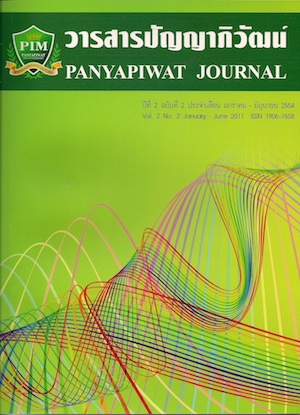ระบบรหัสลับที่เพิ่มความปลอดภัยให้กับข้อมูล
Main Article Content
Abstract
บทคัดย่อ
บทความฉบับนี้มีวัตถุประสงค์เพื่อนำเสนอวิวัฒนาการของการเข้ารหัสลับ โดยเริ่มต้นจากวิธีการเข้ารหัสแบบซีซาร์ ซึ่งการเข้ารหัสนี้ถูกตั้งชื่อตามจูเลียส ซีซาร์ ผู้ที่นำวิธีการเข้ารหัสลับมาใช้ในการติดต่อกับเหล่าแม่ทัพในยามศึกสงคราม ต่อมาได้มีการพัฒนาวิธีการเข้ารหัสลับแบบต่าง ๆ เพื่อให้การสื่อสารข้อมูลมีความปลอดภัยมากขึ้น จนกระทั่งในปัจจุบันวิธีการเข้ารหัสลับข้อมูลที่ได้รับนิยมเป็นอย่างมากมีอยู่ 2 วิธี ได้แก่ 1. การเข้ารหัสแบบกุญแจลับ 2. การเข้ารหัสลับแบบกุญแจสาธารณะ ในบทความฉบับนี้ได้เปรียบเทียบข้อดีและข้อเสียของวิธีการเข้ารหัสลับทั้ง 2 แบบ พร้อมทั้งแสดงวิธีการนำการเข้ารหัสลับแบบกุญแจสาธารณะด้วยวิธี RSA ไปใช้ประโยชน์ในเรื่องของความต้องการความเป็นส่วนตัวและการยืนยันตัวบุคคล สำหรับส่วนสุดท้ายของบทความฉบับนี้ได้กล่าวถึงปัจจัยที่มีผลต่อความปลอดภัยของวิธีการเข้ารหัสลับแบบกุญแจสาธารณะด้วยวิธี RSA
คำสำคัญ : การเข้ารหัสลับแบบกุญแจสาธารณะ, การเข้ารหัสแบบกุญแจลับ, RSA
Abstract
This article presents the evolution of cryptography since the initiation of Caesar cipher, the encryption technique named after Julius Caesar who had invented encryption to communicate with his generals during wartime. Later several methods have been developed to improve the communication security. Recently the secret key encryption and the public key encryption have become the most popular encryption techniques. The advantages and disadvantages of these two techniques have been discussed in this article. We also show how RSA, the most famous of the public key cryptosystem, provides cryptographic privacy and authentication for data communication. Finally, the security issues related to RSA encryption have been discussed.
Keywords : Public key cryptography, Secret key cryptography, RSA
Article Details
I and co-author(s) certify that articles of this proposal had not yet been published and is not in the process of publication in journals or other published sources. I and co-author accept the rules of the manuscript consideration. Both agree that the editors have the right to consider and make recommendations to the appropriate source. With this rights offering articles that have been published to Panyapiwat Institute of Management. If there is a claim of copyright infringement on the part of the text or graphics that appear in the article. I and co-author(s) agree on sole responsibility.
References
Atkins, D., Snyder, J., Hare, C. (1997). Internet Security Professional Reference 2nd edition.Indianapolis: New Riders Publishing.
Buchmann, J.A. (2004). Introduction to crypto-graphy. New York: Springer.
Coutinho, S.C. (1999). The Mathematics of Ciphers: Number Theory and RSA Crypto-graphy. Massachusetts: A K Peters Press.
Denning, D.E. (1982). Cryptography and data security. Massachusetts: Addison-Wesley Publishing.
DI Management Services Pty Limited. (2011). RSA Algorithm. Retrieved January 15, 2011, from RSA Algorithm Website: http://www.di-gt.com.au/rsa_alg.html
Feisthammel, P. (2004). PGP - Pretty Good Privacy. Retrieved January 15, 2011, from PGP/GnuPGP/OpenPGP - Pretty Good Privacy Website: http://www.rubin.ch/pgp/pgp.en.html
Henk, C. A. (2000). Fundamentals of Cryptology. Boston: Kluwer Academic Publishers.
Janeba, M. (1994). Factoring Challenge Conquered - With a Little Help From Willamette. Retrieved January 15, 2011, from RSA-129 article Website: http://www.willamette.edu/~mjaneba/rsa129.html
Mao, W. (2004). Modern Cryptography, Theory & Practice. New Jersey: Prentice Hall.
Mel, H. X., Baker, D. (2001). Cryptography decrypted. Boston: Addison-Wesley.

